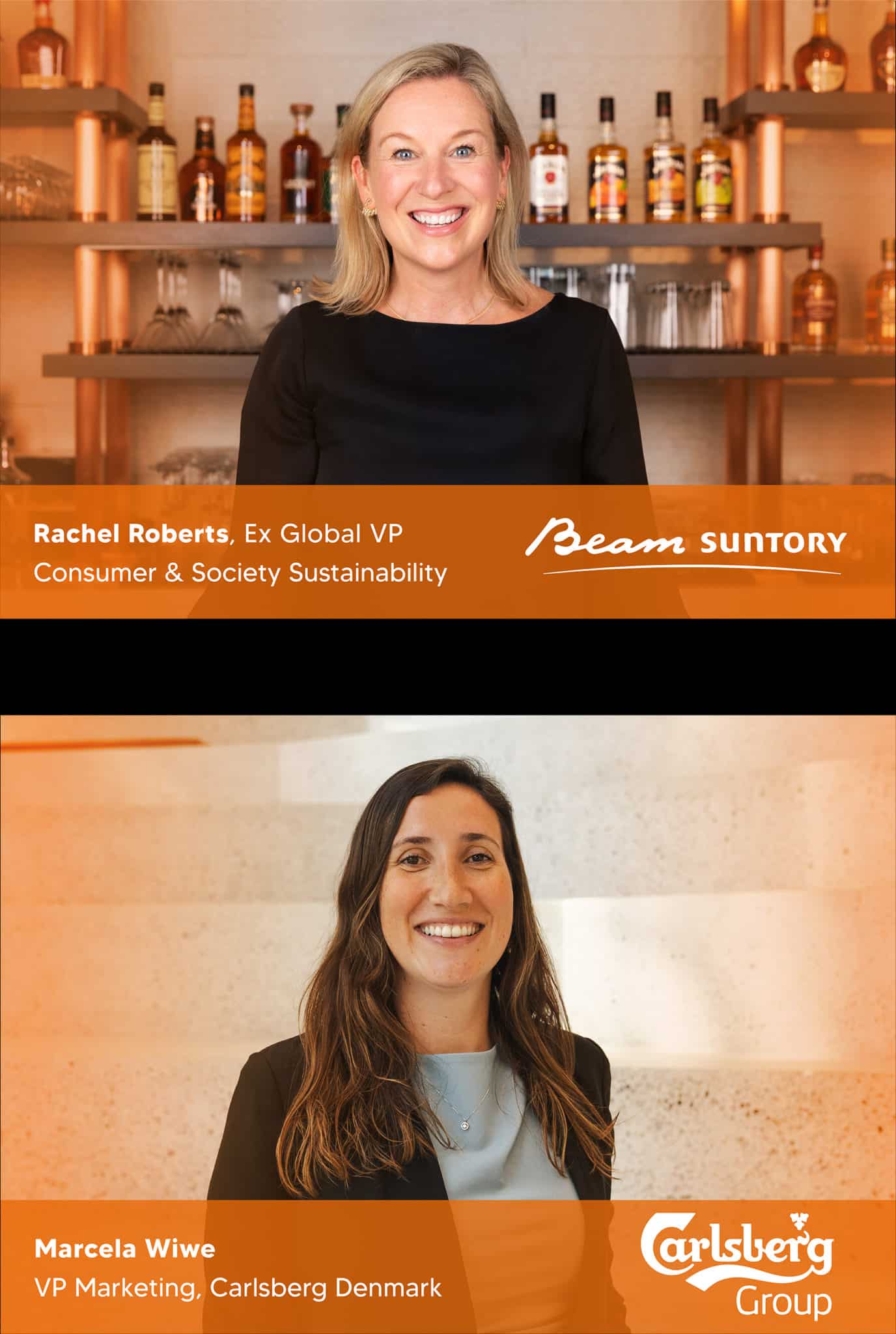ENACTING CHANGE ISN’T EASY...
…especially in the world of packaged goods.
At major FMCG organisations, you need buy-in from stakeholders around the world; from the shop floor to the boardroom in the sky. This is a real challenge for marketers – especially in the current economic climate.
Supply chain issues, inflation and the rising cost-of-living mean that budgets are tight. But FMCG businesses can’t afford to stand still. The cultural currents of society are in a constant state of flux – and brands must track and adapt to these shifting sands to continue to grow.
So how can senior leaders effectively drive commercial
transformation and enact meaningful change?
We spoke to two experts who have spent their careers
transforming some of the biggest brands and businesses
in the world:
Rachel Roberts, Ex Global VP, Consumer & Society Sustainability, Beam Suntory
Marcela Wiwe, Vice President of Marketing, Carlsberg Denmark
Rachel and Marcela have pioneered new products, landed global growth visions and shaped the future of sustainability.
Here’s what we learned…


DON’T TALK LIKE A MARKETER
Driving commercial transformation internally isn’t easy, Rachel Roberts noted. “There are so many different approaches and strategies to get stakeholders engaged.”
“I’ve seen great ideas fall by the wayside because they make one poor presentation and fail to capture people’s attention. Ideas can go off on tangents without a compelling strategy to anchor them and keep everyone singing from the same hymn sheet.”
To put it simply, it’s easy to spend lots of time developing a strategy, and not enough time thinking about how to land it effectively internally. Marketers are experts at galvanising and exciting audiences. But this talent is often concentrated purely on their consumer audience – and not internal stakeholders.
“You need to think clearly about consumer needs and the opportunity”, Rachel continued. “But you need to be clever about how you show this. Marketers can talk till the cows come home about their brilliant strategies and research – shining a light on the work they’ve done.”
“But this isn’t an opportunity to justify your job – your job is to get these people excited. Put yourself in their shoes. Your audience is probably on their fifth Zoom in a row. They are bored. They need the loo. The last thing they need is another bloody marketing presentation.
“So don’t talk like a marketer. Talk like a business leader. Show that you are thinking about the pressures facing key stakeholders across the business. Jolt people out of their day-to-day. If your idea is genuinely exciting, why would your meeting be boring? Getting this wrong can mean a great idea never sees the light of day.”.
VISION & DEPTH
Marcela agreed with Rachel’s perspective on putting yourself in the shoes of the stakeholders you are pitching to, emphasising the need to show ‘big picture thinking’.
“For any idea to get buy-in, people need to understand why you have come to them. Build a business case which demands attention. And then think of a creative way to bring this case to life.”
“At Carlsberg we have a light governance approach – so you need to bring people on a journey with you. Coming into the office is an important part of this. Good pitches begin way before the meeting – they start at the water cooler weeks before. Inspiration and excitement starts in small moments and spreads into something bigger.”
“You need evidence too. You can’t just state that ‘alcohol free is the future’ – and think your job is done. Don’t say you want to be “big” – say exactly how big you want to be, where and when,” Marcela continued.
“Use the advantages big organisations have. You can tap into knowledge from markets around the globe. Use this network. For example, we made a compelling case for premiumising beer in the UK. We talked specifically about how big the opportunity was, using Spain as a real world example to define the size of prize. Give people confidence through sharp strategy, real world data and positivity.”


DISRUPTIVE STIMULATION
Attention is the lifeblood of marketing. And this is as true with driving interest internally, as it is with communication to consumers.
Marcela reflected on her experience at Carlsberg. “Access to interesting people and ideas is important. Get someone unexpected to talk to and present to your teams. This helps break organisational silos – where
people may feel unmoved to engage if it doesn’t speak to their specific role.”.
“This is very important when pitching innovative ideas linked to trends like sustainability. We know it matters to the planet. And we know it matters to consumers. But sustainable ideas often don’t have clear ROI and require lots of work – so you need people to be excited or otherwise these innovations become easy to ignore.”
Rachel Roberts agreed. “At Beam Suntory, we held a marketing conference to stimulate broader thinking. We invited inspirational leaders from parallel sectors to share their thinking. People came and expected to sit through hours of marketing presentations – instead we held a session with the AirBnb CMO. The ensuing Q&A lasted for almost two hours. That’s real engagement.”
But it’s not always about capturing attention. Sometimes, it’s about giving it. “I once went and presented a plan for a new product to the team who would be physically producing it at the manufacturing plant,” recalled Rachel. “It was tough – they took no prisoners with their questions.”.
“But they appreciated that I went to speak and consult with them directly – and we formed relationships which helped get things moving later down the line and push our ideas out the door.”
EMBRACE THE TRICKY
Any successful product, innovation or new strategy will have been thoroughly interrogated internally before it arrives on a shelf or in the best practice manual. And these inquisitions can be anxiety-inducing for the marketers presenting their thinking.
But tricky questions are a strong indicator of a good idea.
“Great plans, and great ideas, are worth fighting for. But they won’t always be easy to sell-in,” Rachel noted. “Tricky questions mean that someone has actually listened. Tricky means they are thinking. They are already invested. This is a huge green flag.”.
“When you structure a presentation, don’t do 55 minutes presenting and leave five minutes for questions. Make it a 50:50 split. Debate is a sign of engagement. Everything should prompt discussion.”
“Marketers are passionate about their brands. But this passion can’t lead to evangelical tunnel vision,” Rachel summarised. “You need to embrace questions – and illustrate how your product fits into the context of the wider landscape. Translate what you think is great into a KPI which makes it a priority for commercial teams. Get people talking internally.”
“But most importantly, trust your gut. Falling at a hurdle isn’t the same as failing. Passion, research and determination will take you – and your ideas – a long way.”
Commercial transformation happens when marketers become leaders. It’s the art of engaging people and uniting them behind a common goal.
To do this, you need to have your finger on the pulse of stakeholder pressures internally as much as you understand consumer behaviours externally. This insight empowers marketers to communicate ideas which excite audiences, demand attention and drive real change.
For more insights, or to learn how Haines McGregor supercharges commercial transformation and innovation for the largest FMCG brands globally, get in touch with the team directly at Hayley.Roe@hainesmcgregor.co.uk or call on +44 7787 546747.






